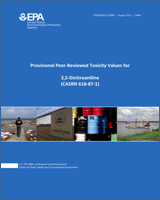NCBI Bookshelf. A service of the National Library of Medicine, National Institutes of Health.
Carlson LM, Dean J, Stanek J, et al. Provisional Peer-Reviewed Toxicity Values for 3,5-Dinitroaniline (CASRN 618-87-1). Cincinnati (OH): U.S. Environmental Protection Agency; 2021 Aug.

Provisional Peer-Reviewed Toxicity Values for 3,5-Dinitroaniline (CASRN 618-87-1).
Show detailsAs shown in Tables 3A and 3B, there are no potentially relevant short-term, subchronic, chronic, developmental, or reproductive toxicity studies of 3,5-dinitroaniline in humans or animals exposed by oral or inhalation routes. The phrase “statistical significance” and the term “significant,” used throughout the document, indicate a p-value of < 0.05 unless otherwise specified.
Table 3A
Summary of Potentially Relevant Noncancer Data for 3,5-Dinitroaniline (CASRN 618-87-1).
Table 3B
Summary of Potentially Relevant Cancer Data for 3,5-Dinitroaniline (CASRN 618-87-1).
2.1. HUMAN STUDIES
2.1.1. Oral Exposures
No studies have been identified.
2.1.2. Inhalation Exposures
No studies have been identified.
2.2. ANIMAL STUDIES
2.2.1. Oral Exposures
No studies have been identified.
2.2.2. Inhalation Exposures
No studies have been identified.
2.3. OTHER DATA (SHORT-TERM TESTS, OTHER EXAMINATIONS)
Data pertaining to the toxicity of 3,5-dinitroaniline are limited to in vitro genotoxicity studies, as described below.
2.3.1. Genotoxicity
Genotoxicity studies of 3,5-dinitroaniline are summarized in Table 4. 3,5-Dinitroaniline was mutagenic when tested in Salmonella typhimurium strains TA98 and TA100 with or without metabolic activation (Assmann et al., 1997). Positive findings for 3,5-dinitroaniline were reported in S. typhimurium strains TA98, TA100, TA1537, and TA1538 without metabolic activation, and in TA1535 with or without metabolic activation, when tested at concentrations between 0.5 and 40 μg/plate (Spanggord et al., 1982). In the same study, 3,5-dinitroaniline was not mutagenic in strain TA100NR3 (mutant lacking nitroreductase activity) with or without activation.
Table 4
Summary of 3,5-Dinitroaniline (CASRN 618-87-1) Genotoxicity.
- REVIEW OF POTENTIALLY RELEVANT DATA (NONCANCER AND CANCER) - Provisional Peer-Re...REVIEW OF POTENTIALLY RELEVANT DATA (NONCANCER AND CANCER) - Provisional Peer-Reviewed Toxicity Values for 3,5-Dinitroaniline (CASRN 618-87-1)
- Myrmarachne spissa voucher PUZ-IMP-1073 cytochrome c oxidase subunit 1 (COI) gen...Myrmarachne spissa voucher PUZ-IMP-1073 cytochrome c oxidase subunit 1 (COI) gene, partial cds; mitochondrialgi|1240504340|gb|KY587560.1|Nucleotide
Your browsing activity is empty.
Activity recording is turned off.
See more...